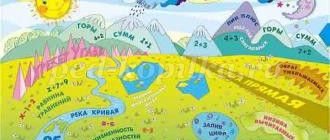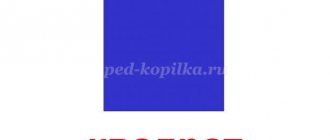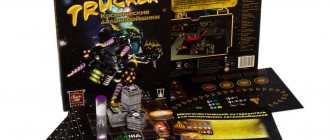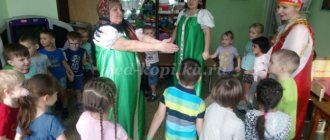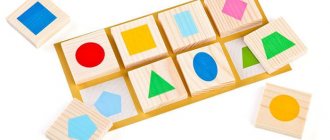Lesson notes for educators and teachers
Topic: Geometric shapes
Goal: To consolidate concepts about geometric shapes. Summarize knowledge about the properties of shapes
(color, size). Strengthen ordinal counting within 10. Enrich your vocabulary.
Develop logical thinking, tactile and long-term memory, proper breathing, listening skills, fine motor skills.
Cultivate accuracy and self-control.
PROGRESS.
Psycho-gymnastics.
-Look how many guests have come to us, say hello to the guests. -Sit more comfortably on a chair, close your eyes and listen - how is it in our office? Quiet or loud?
-Now close your eyes and listen to what is happening behind the door. - Loud, why loud?
-Someone is knocking on our door, someone is probably late for our lesson. Let's invite a guest.
-Look, this is a box, what geometric shape does the side of the box resemble? And this?
A box with something written on it. -Let's read it! Can you help me?
- Parcel for Maxim.
- Who is Maxim? So this is for you. Let's see what's inside it. -This is a package of tasks and we need to complete them.
Envelope No. 1
-There are geometric shapes in the envelope, name them.
-Using the same figures, you can create new geometric
figures.
-Attach these figures first. Then, without looking into the bag, by touch find the figures that I will name.
-Well done, you completed the task! Let's move on to the next task
-Take the envelope with the number 2 written on it.
Envelope No. 2
-What do I have? This is a frame. What shape is it? What geometric shapes does it consist of?
-Now we will make a square from different figures. What color is the square, what shapes did you make it from, how many corners, how can I say it differently?
- Well done, you did it. Let's put our squares in the parcel.
-Now what number is the next envelope?
Envelope No. 3
-Look what's in the envelope? We need the lace for the next task.
-After all, with the help of geometric shapes, you can not only create new shapes and assemble the shapes themselves using different ones. But the objects of our life themselves symbolize geometric shapes. Now, we need to match the figure with the object using laces.
-Well done! Let's move on to the next task. Envelope with number 4
Envelope No. 4
-What is this? What do we need the tube for? You can also breathe into it.
-You will blow into the tube so as to roll the ball to the top and hit
hole.
Envelope No. 5
-Here we have drawn figures, you need to draw them with the help of a ball, but at the same time close your eyes.
-Well done!
Envelope No. 6
-We have a marker. And we need to solve examples.
-I really liked the way you solved the examples.
-Let's see what we have in the next envelope under the number 7
Envelope No. 7
And we have geometric shapes. Tell me we can make something out of
these figures. Build what you want.
What or Who did you depict? What else can be built?
And what's in the last envelope? What number...
Envelope No. 8
And here is a cutaway picture. Let's collect it. And we will have the task on the computer.
- Help the car get to the house by choosing the correct path from the shapes
- Help the car get to the house by choosing the correct path by color.
- Look at the lights of the house and remember them. Now put them the way they were for me.
4. Tell me what time of year it is? It's cold outside and icicles will appear soon. I already have icicles, I just need to paint them.
Result: name the figures we talked about. Which group can we unite into? What is another name for them? What are these figures?
Maxim, look at our parcel - it has become a great parcel of your knowledge.
Source: https://konspekty-zanyatij.ru/uchebnye-materialy/konspekt-zanyatiya-po-femp-v-starshej-gruppe-geometricheskie-figury/
Summary of a mathematics lesson in the senior group: ON THE TOPIC: “GEOMETRIC FIGURES”
SUMMARY OF AN OPEN INTEGRATED LESSON ON COGNITIVE DEVELOPMENT (FEMP) AND ARTISTIC AND AESTHETIC DEVELOPMENT (CONSTRUCTIVE-MODEL ACTIVITY) ON THE TOPIC: “GEOMETRIC FIGURES” IN THE SENIOR GROUP
Target:
— improve knowledge about geometric figures and the shape of objects;
Objectives:
Educational:
- consolidate knowledge about geometric shapes;
— to form the experience of independently overcoming difficulties under the guidance of a teacher based on the reflexive method, the experience of self-control;
— improve the ability to correlate numbers with quantities, compare aggregates and establish equality between them;
— practice solving logical problems and ingenuity problems;
— to develop children’s interest in mathematics and a sense of confidence in their knowledge.
- train mental operations - analysis, comparison, generalization, abstraction.
Educational:
- develop attention, memory, speech, fantasy, imagination, logical thinking, creativity, initiative;
- develop fine motor skills of the hands.
Educators:
— cultivate positive motivation for learning and interest in mathematics;
- cultivate a friendly attitude towards each other.
Demo material:
signs with the names of stops; toy Old Man - forest girl, image of numbers from 1 to 7 on sheets of A4 size paper for physical education, geometric figures, magnetic board, tray, red and yellow cardboard flowers, poster with a drawing of a flower meadow, poster with a drawing of a geometric country.
Handout:
— number cards from 1 to 5; sets of geometric planar and volumetric figures, album sheets according to the number of children.
- worksheets with tasks “geometric trees”, “geometric houses”, “geometric swings”. Sheets of paper, geometric shapes cut out of colored paper. Methods and techniques:
explanation, instructions, clarification, questions, demonstration, game technique, encouragement, pedagogical assessment.
Educational areas:
Cognitive development (FEMP);
Speech development;
Artistic and aesthetic development (constructive and modeling activities);
Socialization (play activities).
Lesson content:
Ι. Introductory part:
Organizing time.
Greeting game “Our smart heads”
Our smart heads will think a lot, cleverly. The ears will listen, the mouth will speak clearly. Hands will clap, Feet will stomp. Our backs straighten, we smile at each other,
The lesson begins.
ΙΙ. Main part.
Educator:
- Attention, guys! I want to inform you that today we want to take a trip. I know the magic words that will help us go on a journey to the land of geometric shapes. What geometric shapes do you know? (children's answers).
Abstract of GCD for FEMP “Geometric figures - unusual natures”
- February 21, 2015
Competition “My Pedagogical Initiative - 2014”
Nomination “New educational standards in my practice”
Relevance and practical significance
The educational field “Cognitive development” is one of the main ones in the development and formation of a child’s diversified personality. And the formation of elementary mathematical concepts and their further application will contribute to the development of logic, memory, attention and spatial thinking.
The principle of continuity in preschool and school education makes it possible to make it continuous and progressive - in this case, any knowledge acquired in a preschool institution will be in demand and expanded in primary and then high school. Therefore, it is necessary that the preschooler’s conceptual apparatus includes terms that will be basic when studying mathematics at school, and will not contradict newly acquired knowledge.
An important factor in the successful formation of elementary mathematical concepts is their actualization. At preschool age, the child does not yet prioritize: “knowledge for the sake of knowledge itself,” but operates with the concept of “interesting.” Therefore, when introducing any new concept and consolidating previously acquired knowledge, it is necessary to interest the child in the very method of introducing and consolidating it. At the same time, make sure that it is not only interesting for the child, but also understandable, and take into account his age and individual characteristics.
Goal: To consolidate knowledge about geometric shapes through experimental activities.
Educational objectives:
1. Develop skills for independent work with practical material.
2. Teach children to make a rectangle from two strips of paper.
3. Teach children to make a pentagon from a strip of paper.
4. Strengthen the skill of orientation on a plane.
Developmental tasks:
1. Develop interest in non-standard methods of expanding the conceptual apparatus in the formation of elementary mathematical concepts.
2. Develop memory, logical thinking, imagination, attention, intelligence.
3. Develop the ability to engage in experimental activities.
4. Develop the ability to work in a group.
Educational tasks:
1. Cultivate interest in mathematical knowledge.
2. Cultivate interest in educational and experimental activities.
3. Cultivate diligence and accuracy.
Methodical techniques:
1. Visual and demonstrative (use of visual material).
2. Verbal (story, explanation, dialogue with children).
3. Practical (working with strips of paper (experimental activities) and performing work according to instructions).
Equipment and handouts: Strips of paper of two colors (yellow and two pink, different lengths) - 3 cm wide; glue stick; colour pencils; scissors; geometric shapes in a container; scarf.
Abstract of GCD for FEMP “Geometric figures - unusual natures”
Author: Irina Aleksandrovna Second, teacher of the first qualification category, 8 years of teaching experience, MBDOU kindergarten No. 70 of a combined type, Bolshiye Vyazemy rural settlement, Moscow region, Odintsovo district.
Learning geometric shapes with kids in preschool educational institutions
When studying geometric concepts, children also gain other knowledge and skills in parallel:
- they learn to think logically;
- get the opportunity to develop knowledge of the Russian language;
- the perception of space and the ability to navigate in it improves;
- children develop fine motor skills;
- Intellectual qualities develop: the ability to make comparisons, analyze, and generalize.
Note! When teaching in kindergarten, the development of geometric concepts is not highlighted as a separate topic, but occurs in combination with other topics.
Children learn geometry
Learning colors and shapes for children from 2 years old
Geometry learning should begin with the simplest figures; more complex ones should be left for subsequent years. It is believed that children are able to perceive shape on a subconscious level within six months after birth. At this time, the main way of teaching is through mention during the story. When showing pictures, you can casually notice that the objects depicted have a certain shape.
When teaching, you need to take into account that kids can only learn to distinguish between the simplest ones: circle, square and triangle.
Note! Studying in a year or two or three should be easy and fun. For mastering it is convenient to use three-dimensional figures. Studying, for example, a circle, you can imagine that he came to visit the baby. You can use your child's finger to trace a circle along the outline. You can make such an applique, decorating it with eyes and a nose.
What educational areas in preschool educational institutions are provided for by the Federal State Educational Standard for Preschool Education?
A child can play with this item: make a tower by placing one on top of the other, throw it to the side or put it in a box.
This integrated approach to a geometric design project is very effective for toddlers, but for younger children it can be considered the primary way to learn shapes.
For children under two years of age, the following may be used:
- children's ability to compare objects;
- use a children's educational set, where you need to select a hole of a suitable shape and size for the figurine.
A two-year-old child is able to choose the appropriate shape from a set.
When they teach figures to 3-year-old children, they can already show the one that was named by the teacher.
Learning figures for children 3 years old
When teaching children geometric shapes, it is important to consolidate familiarity with the material that they have previously learned. We need to continue studying and move on to those that are more difficult to understand - oval, rhombus and rectangle.
When teaching children, you can show children examples of figures, letters of the alphabet and compare them with other objects in shape and size.
Important! During the walk, children are told about the objects they see, mentioning their shape and simple geometric properties.
An important role when teaching geometric shapes to children is played by creative activities, when children draw or sculpt samples and put them together from a given set of component parts.
Using cards depicting complex objects, the child is asked to talk about the components in the form of certain shapes.
Children education poster
Geometric shapes in the senior group
At this time, the lessons move on to considering new, more difficult to understand figures, repeating those that they should have known before.
In classes at the age of five, children are asked to consider and talk about their common and different properties. For example, questions are asked about where open figures have corners and in which cases they do not.
They try to teach children to analyze the complex shapes of real objects, to find elements in them that have the form of simple figures. They learn about more complex shapes, such as a cone.
Geometric shapes in the preparatory group
At this age, children have already mastered the basics of understanding the shapes of objects. At this stage, it is important to develop knowledge and make it more systematic. At this age, children develop a foundation for schooling.
Note! Children in the preparatory group, when introduced to polygons, are told about their sides and angles, and are taught to find the desired figure using a description.
Here is an example of an educational game that can be included in a lesson note and used for teaching. Children are given a set of figures. The player places one of them. Another should put next to it one that differs in only one attribute. For example, if one offers a large blue square, then the other may lay out a small blue square, a large yellow square, or a large blue circle.
The teacher tells the children about the figures
Summary of the Oud "Magic Figures"
Summary of organizational educational activities for FEMP “Magic Figures” (second junior group)
Educational area:
“Cognition”
Section:
“FEMP”
Tasks:
Teach children to distinguish and correctly name geometric figures, consolidate knowledge of primary colors: green, red, blue, yellow, exercise children in examining patterns of figures in different ways (tracing the outline of a figure with a finger; drawing the outline of a figure in the air; rolling a geometric figure; feeling a geometric figure with hands ), name objects of round, square and triangular shape, consolidate the ability to determine the size of objects, reflect the result of comparison in speech: large, small, smaller, high - low, shortest, longest and longest. To develop imaginative thinking, imagination, and memory in children. Cultivate perseverance and cognitive interest in the lesson.
Morning circle:
- Hello, sun!
- Hello, sky!
- Hello, all my land!
—
We woke up very early! - And we welcome you!
Progress of the lesson:
Surprise moment: I invite the children to join the group.
Guys, look how beautiful it is in our group. An exciting journey awaits us today. Look at the balls, what color do you see the balls? That's right, our group is decorated with red, green, blue and yellow balls. Look, there are still three paths that lead to the houses. Guys, are the tracks all the same?
- What are they like? (Children's answers).
— That's right, they are all different in color and length.
- Let's take the shortest path.
-Look at the house we came to (the small one).
-Do you want to know who lives in the smallest house?
- And for this you need to guess the riddle:
Jumps deftly, gnaws carrots... who is this? (Hare)
- Guys, the bunny has prepared cards for us and wants to see how we know geometric shapes (shows geometric shapes: circle, square, triangle). (Children, without difficulty, name geometric shapes).
- Well done, the bunny is very glad that you know geometric shapes and has prepared a surprise for you:
Physical exercise:
“
Mice”
One day the mice came out.
See what time it is.
One, two, three, four - the mice pulled the weights.
Suddenly there was a terrible thunder -
The mice ran away.
-We rested a little, and now you and I are going further and will follow the blue path.
-Tell me, please, which track is longer, red or blue?
-That's right, the blue path is longer.
-Which house do you see? (big)
-Let's find out who lives in this house: I'll tell you a riddle and you can guess it. Fluffy tail, golden fur, lives in the forest, steals chickens in the village! (fox)
-Well done! The fox invites you to play a game called “Build Houses.”
— There are geometric shapes in a box on the table, you will need to make a house for the fox out of them.
-What beautiful houses you have made!
-Andryusha, what color is your house? What figures does it consist of?
- Guys, did your houses all turn out the same or different?
- Guys, look, we have one more path left, what is its size and color?
— That’s right, this path is the longest and it’s green.
— Follow me along the green path. What house do you see near the green path? (big)
-Now tell me, which house is bigger, on the blue path or on the green one? (children's answers)
- I wonder who lives in such a big house, let's solve the riddle and find out who lives here:
Clumsy, clubfooted, when he sleeps, he sucks his paw,
He eats raspberries, loves honey, and his name? (bear)
-Mishka wants to play the game “Find Your Place” with you, for this I will give you medals with the image of a geometric figure, and you will need to find a chair with the same figure and sit on it.
— Guys, who did we visit today?
- How many paths have we walked? Let's count.
— What color were the paths?
—Which path was the longest?
- Which path was the shortest?
- Well done! The bunny, fox and bear really enjoyed playing with you today, but they need to go to the forest to see their children. Children say goodbye to animals.
